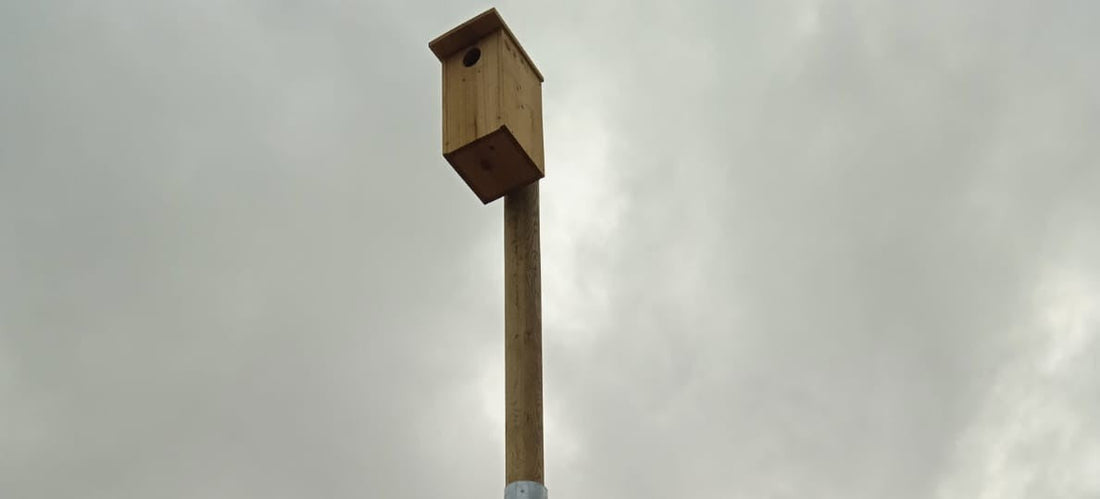
Environmental compensatory measures in photovoltaic solar plants (PSFV)
Share
The transition to renewable energy sources is essential to combat climate change and reduce our dependence on fossil fuels. Solar photovoltaic plants (PVPs) have become one of the most effective solutions for generating clean energy, but, like any infrastructure, their installation can have an environmental impact on the surrounding ecosystems. This is why compensatory environmental measures They play a key role in minimizing these effects and ensuring that the development of these energies is not harmful to biodiversity.
Among these measures, the nest boxes They stand out as an accessible and effective solution for promoting the conservation of local wildlife, especially in the rural and natural areas where many of these solar plants are installed. This article explores how nest boxes can be integrated into PVSP projects as a compensatory measure to protect biodiversity.
What are compensatory environmental measures in PSFV?
Although solar photovoltaic plants are a clean energy source, they can disrupt natural habitats during their construction and operation. The installation process, which includes site preparation, solar panel placement, and associated infrastructure construction, can affect local flora and fauna. To mitigate these impacts, measures are implemented. compensatory environmental measures .
These measures are actions that seek to restore or improve the environment as a way to offset the damage caused by a project. In the case of solar plants, measures may include the restoration of degraded areas, the creation of ecological corridors, reforestation, and, in many cases, the installation of nest boxes to provide shelter for species of birds and other animals that inhabit the area.
Why are compensatory measures necessary in PSFV?
Despite the environmental benefits of solar energy, photovoltaic plants can have certain negative effects on the environment, such as the alteration of wildlife habitats, the modification of local vegetation, and the fragmentation of ecosystems. For example, the construction of a solar plant in an agricultural or natural area can displace species of birds, mammals, and reptiles that inhabit it.
The compensatory measures ensure that these impacts are minimized or counteracted by restoring habitats, creating new protected areas, or promoting biodiversity in areas near the project. As with other infrastructure projects, solar plants must follow principles of sustainable development , ensuring that technological progress does not come at the cost of biodiversity loss.

The role of nest boxes in the environmental compensation of PSFVs
One of the most effective and easy-to-implement compensatory measures in solar plants is the installation of Nest boxes . These structures provide shelter and nesting sites for various bird species that may be displaced by plant construction. Next, we'll look at how nest boxes contribute to the conservation of local wildlife and how they can be an integral part of an environmental offset plan for solar plants.
- Mitigating the impact on biodiversity: The construction of solar plants can reduce the availability of suitable habitats for wildlife, including nesting sites for birds. Nest boxes can help offset this loss by providing a safe and suitable place for birds to nest and raise their young.
- Adaptation to local species: Nest boxes should be designed and located to be appropriate for the species of birds and other animals that inhabit the area, considering their nesting needs and behavior.
- Consideration of endangered species: If endangered wildlife species are identified in the area, special measures must be taken to protect their habitats and ensure their survival, including the installation of nest boxes specifically designed for these species.
-
Scientific studies and monitoring: Nest boxes can facilitate the study and monitoring of wildlife in the solar plant area, allowing for a better understanding of the project's effects on biodiversity and an assessment of the effectiveness of compensation measures.
- Environmental awareness: The installation of nest boxes can serve as an element of environmental awareness, demonstrating the solar plant's commitment to biodiversity conservation and raising community awareness about the importance of environmental protection.
Benefits of integrating nesting boxes into solar projects
Installing nest boxes at solar farms not only benefits local species, but also offers advantages for the companies and administrations responsible for the project. Some of these advantages include:
- Environmental Compliance : Compensatory measures, including nest boxes, are often required by environmental legislation in many countries, helping companies comply with regulations and avoid penalties.
- Improving corporate image : Conservation initiatives, such as installing nest boxes, are highly valued by the public and can enhance a company's reputation, demonstrating its commitment to sustainability and environmental protection.
- Long-term ecological benefits : In addition to protecting biodiversity, nest boxes contribute to the resilience of local ecosystems, which can be key to the long-term stability of solar plants by maintaining the natural balance of the surrounding area.

Conclusion
The transition to solar energy is an important step toward a more sustainable future, but it is essential that its development not come at the expense of local biodiversity. compensatory environmental measures , such as the installation of Nest boxes play a crucial role in mitigating the environmental impacts of solar photovoltaic plants. By providing shelter for various bird species and encouraging natural pest control, nest boxes contribute significantly to the conservation of local wildlife, while solar plants continue to produce clean, sustainable energy.
Integrating solutions such as nesting boxes into solar projects is not only beneficial for the environment, but also reinforces the companies' commitment to sustainability and the biodiversity , ensuring development that respects the natural balance of our planet.
